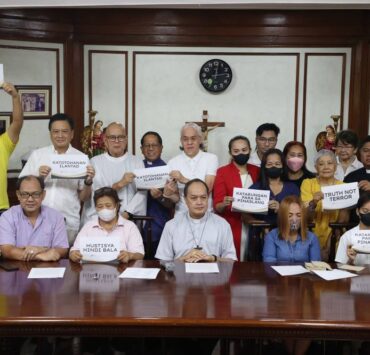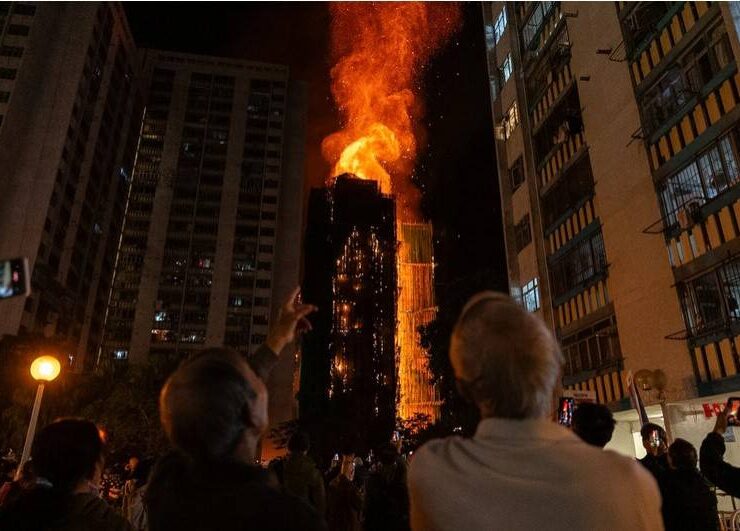Marcos ‘very sorry’ for ‘Tino’ deaths

President Marcos on Friday said he was “very, very sorry” for the high number of casualties and widespread destruction caused by Typhoon “Tino” (international name: Kalmaegi).
He made the apology following a situation briefing at the Cebu provincial capitol, where he discussed with local officials the recovery of the province.
“We are very, very sorry. We are all sad because our casualty figures are very high… and many of them were swept by the floods because of how strong and quick the flash floods were,” he said.
The President attributed the heavy volume of floodwaters that submerged several parts of Cebu to failed flood control projects in the province.
State of nat’l calamity
“We saw that the dikes and protections that were previously installed were not really able to withstand the weight and amount of water that fell,” he noted.
Malacañang earlier said it wanted an investigation into the 343 flood control projects in Cebu from 2016 to 2022 that could have helped the province during Tino’s onslaught.
Mr. Marcos declared on Thursday a state of national calamity following Tino’s devastation, to enable government agencies to draw from emergency funds and hasten the procurement of essential goods and services for typhoon victims.
On Friday, the President visited Liloan town and Talisay City in Cebu to oversee the distribution of assistance to those affected by Tino.
Liloan is among the areas hardest hit by the typhoon. Tiltilon Elementary School in Barangay Cotcot, the first stop of the President’s visit, serves as an evacuation center for 126 families (509 people).
Widespread destruction
The Department of Health in Central Visayas region also conducted a rapid health assessment at the evacuation center and provided free medical consultations and medicines, including maintenance drugs, antibiotics, doxycycline for leptospirosis prevention, and antitetanus vaccines for those with injuries.
After his visit to Liloan, Mr. Marcos proceeded to Talisay Sports Academy in Talisay City.
As of Friday morning, the death toll had jumped to 188, with 135 still missing and 96 injured, according to Office of Civil Defense deputy spokesperson Diego Mariano.
Cebu bore the brunt of Tino, logging the most number of deaths at 139.
Mariano said the data that the OCD released was also based on a report by the National Disaster Risk Reduction Management Council (NDRRMC), which cautioned that the fatality toll was still subject to validation and could still change.
Twenty-four deaths were reported in Negros Occidental, nine in Negros Oriental, six in Agusan del Sur, three in Capiz, two in Southern Leyte, and one each in Antique, Iloilo, Guimaras, Bohol, and Leyte.
Of the 135 reported missing, most were in Cebu at 79, followed by Negros Occidental at 39, and Negros Oriental at 17.
Cebu logged 84 injuries, followed by Negros Occidental with seven, Surigao del Norte and Leyte with two each, and Surigao del Sur with one.
Per the NDRRMC, more than 2.2 million people were affected by Tino, with 397,634 still in evacuation centers.
Before exiting the Philippine area of responsibility on Thursday, Tino made landfall eight times and left widespread destruction in parts of the Visayas and Mindanao. A potential supertyphoon, “Uwan” (Fung-wong), is forecast to follow in its wake and enter the country by the weekend. (See story on Page A2)
On Thursday, Acting Cebu City Mayor Winston Pepito said that while some aid had reached the hardest-hit upland areas, many evacuation sites still lacked basic provisions, particularly water and electricity.
The city’s total displaced population now exceeds 15,700 individuals, with most of them staying in public schools and gymnasiums, according to the Cebu City Disaster Risk Reduction and Management Office (CCDRRMO).
At least 50 barangays had reported evacuees as of Thursday morning. In the north, 576 families (4,222 people) are taking shelter in 34 evacuation centers, while in the southern district, 41 evacuation sites house 2,063 families (11,527 people).
For its part, the Metropolitan Cebu Water District said repair works are still ongoing at the Jaclupan Wellfield Facility in Talisay City, where a pipeline collapsed after massive flooding along the Mananga River, cutting off supply to large secitions of Cebu City.
60-day price freeze
Following the President’s declaration of a state of national calamity, the Department of Trade and Industry (DTI) on Friday ordered a 60-day freeze on the prices of basic necessities nationwide.
Basic necessities include canned fish, such as sardines, processed milk, coffee, locally manufactured instant noodles, salt, bottled water, laundry soap, detergent, and candles.
Before this, the DTI had already imposed a 60-day price freeze on basic goods due to Tino, but only in select areas, such as Guiuan in Eastern Samar, Cebu City, and Dinagat Islands.
Timor-Leste to help
Meanwhile, the Department of Foreign Affairs (DFA) on Friday said Timor-Leste would send 120 engineers and firefighters to help in the recovery and cleanup efforts in affected areas.
Timor-Leste is the newest member state of the Association of Southeast Asian Nations (Asean), which welcomed the country into the bloc last month during the 47th Asean Summit.
Other than the Timor-Leste assistance, the Philippine government is currently not seeking financial assistance from other countries as it still has “sufficient funds” to respond to Tino’s devastation, according to Palace press officer Claire Castro.
“The front-line agencies also have quick response funds that can be replenished, and if these become insufficient—especially for the local government units—they can be assured that they will receive help from the Office of the President through what we call the local government support funds,” Castro said.
Australia, Canada, and the United States have already expressed their readiness to assist the country in its recovery efforts. —WITH REPORTS FROM PIA PIQUERO, KATHLEEN DE VILLA AND LOGAN KAL-EL ZAPANTA





















